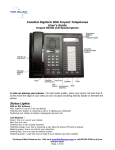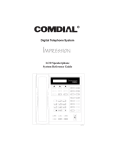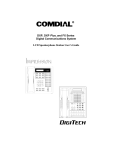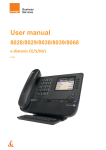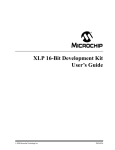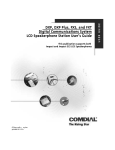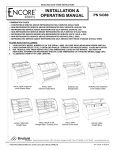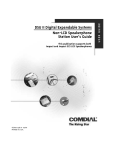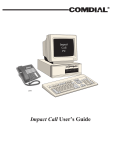Download Impression LCD Speakerphone Station User Guide
Transcript
R Digital Telephone System LCD Speakerphone Station User’s Guide E 1 ABC 2 DEF 3 GHI 4 JKL 5 MNO 6 PRS 7 TUV 8 WXY 9 OPER 0 # SPKR T/C MUTE HOLD TAP ITCM unisyn05.cdr This user’s guide applies to the Impression model 2022S–✳✳ LCD speakerpohone (when used on Comdial Gxxxx common equipment with Ixxxx or Sxxxx software cartridge Revision 18A and later). If you need more information, than this guide provides, please consult your System User’s Guide GCA70–328 LCD Speakerphone Station User's Guide Introducing Your Impression LCD Speakerphone Congratulations and thank you for using an Impression LCD Speakerphone! This manual serves as a helpful guide for using all of the various functions of your new telephone and as a quick reference guide as well. If you should need more information about a particular function or on a function that is not listed in this guide, consult the System User’s Guide, GCA 70–332, (your system attendant or whomever runs your main telephone system should have several copies). Using the Speakerphone Since your telephone is a speakerphone, you can use it handsfree for any operation in which you might use the handset. To use the speakerphone, press the ITCM or the line button instead of lifting the handset. You cannot use the speakerphone mode to receive a SOHVA or to originate paging. LCD Display unisyn08.cdr Interactive Buttons Speaker Mute Button T/C Button 1 2 DEF 3 GHI 4 JKL 5 MNO 6 PRS 7 TUV 8 WXY 9 OPER SPKR Button Message Waiting Light ABC 0 Programmable Buttons # SPKR T/C MUTE HOLD TAP ITCM Volume Control Hold Button TAP Button Microphone Opening ITCM Button LCD Speakerphone Station User's Guide–3 LCD Speakerphone Station User's Guide GCA70–328 Understanding What the Lights Mean The lights on your telephone indicate the status of lines, features, and intercom. —Next to a Direct Station Select (DSS)/ Busy Lamp Field (BLF) button: Steady red = station is in use, or in Do Not Disturb. Flashing red = station is receiving a call or station is calling you. Fluttering red = station-to-station messaging has been set. —Next to a line button: Steady green = line is in use at your station. Steady red = line is in use at another station. Flashing red = your line is ringing. Flashing orange = your line is ringing and will be answered when you take your telephone off hook. Winking green = line is on hold at your station. Winking red = line is on hold at another station Fluttering green = line has recalled from hold at your station. Fluttering red = line has recalled from hold at another station. —Next to a fixed feature or programmable feature button: Steady red = the feature is on. Steady off = the feature is off. —Next to the ITCM button: Steady red with a quick flash = you are using your intercom. Fluttering red = auto redial is in use, or system is in Night Mode (at station 10). Winking red = an LCD message is set on your telephone for others to receive when calling. Flashing red = another station is calling you. 4–LCD Speakerphone Station User's Guide GCA70–328 LCD Speakerphone Station User's Guide —Above the HOLD button: Flashing red = message awaits pick up. Fluttering red = automatic station relocation has been set. —Above the SPKR button: On steady (with telephone on hook and busy) = speakerphone mode active. On steady (with telephone on hook and idle) = background music turned on. On steady (with telephone off hook and busy) = group listen is active. —Above the MUTE button: On steady = called party cannot hear your conversation. unisyn12.cdr Interactive Buttons Mute Light 1 ABC 2 DEF GHI 4 JKL 5 MNO 6 PRS 7 TUV 8 WXY 9 Speaker Light Message Waiting Light OPER 0 3 Line Lights, DSS/BLF Lights (one for each button) # SPKR T/C MUTE HOLD TAP ITCM Hold Light Intercom Light LCD Speakerphone Station User's Guide–5 LCD Speakerphone Station User's Guide GCA70–328 Using The LCD Abbreviations The following chart identifies the abbreviations on your LCD screen and provides a brief definition of each feature. For more detailed information, see your system manual, GCA70–332. Abbreviation Feature Definition ADIAL Auto Dial Allows you to program a number as an autodial for one-button dialing. ALL All Call Forward Using Call Forward, you can forward all calls or just personal calls. ANS Answer When an unanswered transfer returns to your station, you can press the ANS button to retrieve the call. ARDL Auto Redial Redials a busy call once a minute for ten minutes. BLOCK SOHVA block Blocks SOHVA calls BKSP Back Space When you are programming an autodial or speed dial, BKSP allows you to erase an incorrect digit. CAMP Camp If you intercom-call a station that is busy, does not answer, or is in DND, CAMP causes the system to ring your station when the called station is available. CFWD Call Forward You can forward calls that normally ring at your station to another station. 6–LCD Speakerphone Station User's Guide GCA70–328 LCD Speakerphone Station User's Guide CLBK Call Back One non-verbal response to a SOHVA is CLBK, which means the station receiving the SOHVA will call back the originating party. CLEAR Clear If your system is set for Call Forward, the CLEAR button cancels the call-forward condition. CWAIT Call Waiting You can send a call-waiting tone to a busy station and await a reply. DARK Dark When adjusting the contrast on your LCD, DARK makes the background of the screen darker. DIAL Dial By Name Dials a number corresponding to a displayed name. DISP Display You can adjust the contrast on your LCD screen. DND Do Not Disturb With DND enabled, your station appears busy to calling stations. DSS Direct Station Select Allows you to store a number as a DSS for one button dialing. EXIT Exit Ends your current programming function. EXT External Chooses speed dial list for dial by name feature. FEAT Feature Accesses several miscellaneous features, such as DND button or Account Code button. FWD Forward If you have set your telephone with call forwarding, FWD displays on your screen along with the name or extension of the station to which your calls will be forwarded. LCD Speakerphone Station User's Guide–7 LCD Speakerphone Station User's Guide GCA70–328 G(followed by number) Group Tells you which line group you are currently using. HOLD Hold Functions just as your fixed HOLD button. HVHLD Have them hold One non-verbal response to a SOHVA, HVHLD tells the calling station to “Have them hold.” INT Internal Chooses intercom number list for dial by name. L (followed by number) Line Tells you which line you are currently using. Last No. Saved Last Number Saved Displayed when SAVE button is pressed and the last dialed number is saved. LIGHT Light When adjusting the contrast on your LCD, LIGHT makes the background of the screen lighter. MUSIC Music You can turn on the background music to play through your speaker. NEXT Next Moves you to the next LCD programming display OVER Override Overrides either a do-not-disturb call or a busy call, depending upon how your station is programmed. P (followed by number) Port Denotes port number of your station. PERS Personal Using Call Forwarding, you can forward all calls or just personal calls. PREV Previous Returns you to the previous LCD display. RECALL Recall Recalls line from hold 8–LCD Speakerphone Station User's Guide GCA70–328 LCD Speakerphone Station User's Guide RECON Reconnect Lets you reconnect to a transferred call if the station is busy. RING Ring You can select a variety of ring tones for your station. S (followed by number) Station denotes your station number. SAVE Save Permanently saves the telephone number of your current call. SDIAL Speed Dial Allows you to program a number as a speed dial for one-button dialing. SEND Send If a transferred call is not answered and recalls to your station, SEND re-transfers the call. SET Set Enables Call Forwarding. SOHVA Subdued Off Hook Voice Announce Sends a subdued message to a busy station. TIMER Timer Displays the running time of the current call. TKMSG Take A Message One non-verbal response to a SOHVA, TKMSG tells the calling station to “Take a message.” VAB Voice Announce Block Inhibits your station from receiving a SOHVA or voice announced intercom call. LCD Speakerphone Station User's Guide–9 LCD Speakerphone Station User's Guide GCA70–328 Answering Calls • To answer a call that is ringing at your telephone, 1. if the light is flashing orange, lift handset; 2. if the light is red, press the flashing line and lift handset. • To answer a call using the speakerphone, press flashing line or ITCM button. • To answer a call that is ringing at any telephone, 1. lift handset, 2. press ITCM and dial ✳ 4 plus extension number of ringing telephone. • To answer a call that is ringing at a particular telephone in your group, 1. hear ringing 2. lift handset, 3. press ITCM and dial # 4 (ringing station must be programmed in your call pickup group). • To answer a call that is ringing the loud ringer or night transfer station, 1. 2. 3. 4. hear ringing , lift handset, press ITCM and dial 80, answer call. 10–LCD Speakerphone Station User's Guide GCA70–328 LCD Speakerphone Station User's Guide Answering Subdued-Off Hook Voice Announcements (SOHVA) Calls NOTE: Your telephone may be arranged to receive a subdued off-hook voice announcement (SOHVA). If it is, an intercom caller may break into your outside call and deliver a message to your telephone receiver for you to hear. SOHVA works as follows: while off-hook on an outside call, hear several quick tone bursts followed by an announcement delivered to your ear through the handset. • To respond verbally, 1. press and hold MUTE, 2. speak into handset. • To respond non-verbally, 1. press MSG, 2. press HVLD (have hold), TKMSG (Take Message), or CLBK (Call Back) depending upon which message you want to leave. NOTE: Announcing station must have LCD speakerphone. • To Block SOHVA, press BLOCK when SOHVA is initiated. LCD Speakerphone Station User's Guide–11 LCD Speakerphone Station User's Guide GCA70–328 Making Calls NOTE: If the installer has enabled your system with Specialized Route Access (SRA), the system returns a special intercom tone when you dial out (using ITCM 9, or a preprogrammed button). After this SRA tone, you have ten (10) seconds to dial digits; otherwise, the telephone automatically returns to its idle state. Furthermore, you only have three seconds pause time between digits before the system automatically dials your call. • To make a call, 1. lift handset, select line (unless your telephone selects it for you), or select ITCM, and listen for dial tone, 2. either dial number or press HOLD, then press autodial, use speed dial feature, use redial feature, or press Direct Station Select (DSS) if making an intercom call. • To dial autodial number, 1. press preprogrammed button. If button is programmed at the second level of a DSS button, press HOLD before pressing autodial button, 2. when called party answers, lift handset. • To dial personal or system speed dial number, 1. dial desired code: 1–0 = personal speed dial number, ✳01–✳99 = system speed dial number, if you select a line, press HOLD then dial code, 2. when called party answers, lift handset. • To redial the last number that you dialed at your telephone, 1. dial #,if you select a line, press HOLD then dial #, 2. when called party answers, lift handset. • To access outside line using line group feature, 1. press ITCM, then dial line group access code: 9 = group 1, 81 = group 2, 82 = group 3, 83 = group 4, 2. listen for outside dial tone, 3. dial number, and lift handset when party answers. 12–LCD Speakerphone Station User's Guide GCA70–328 LCD Speakerphone Station User's Guide • To queue for a line group if all lines are busy, 1. 2. 3. 4. press ITCM and dial line group access code (9, 81, 82, or 83), hear busy tone and dial ✳ 8, hang up and wait for queuing ring-back. when called party answers, lift handset. • To answer queuing ring-back, lift handset and hear dial tone for line. • To cancel queuing before it causes ring-back at your telephone, 1. lift handset, 2. press ITCM and dial # 8, 3. hang up handset. • If you are required to enter an account code when making outside calls, 1. select line, 2. press ITCM and dial ✳ 04, 3. dial your account, hear outside dial tone, and dial outside number, 4. when called party has answered, lift handset. • To use Toll Restriction Override at a station, 1. 2. 3. 4. press ITCM, dial ✴✴6, dial your station extension number, dial your TRO code number (TRO code is not displayed— instead an ✴ is shown), 5. within 15 second timeout period, dial desired outgoing line number. 6. hang up handset or press SPKR to end call. You will have 15 seconds in which you can make another call without re-entering your TRO code. • To clear the Toll Restriction Override code, 1. press ITCM, 2. dial ✴✴6, 3. press SPKR. LCD Speakerphone Station User's Guide–13 LCD Speakerphone Station User's Guide GCA70–328 Camping On At A Station Waiting For A Call Back (Using Automatic Call-Back) • To arrange for the system to call back when a busy station becomes idle or rings with no answer, 1. make intercom call and hear busy signal or ring-back tone, 2. press CAMP, 3. hang up. (When called station becomes idle or is operated by its user, your station will ring. Call-back is canceled if you do not lift your handset when you hear this ringing). • To answer call-back ring, lift handset (called station will ring; call-back is canceled if you do not lift your handset). • To cancel automatic call back, press ITCM and dial # 6. Waiting for An Answer (Using Call Waiting) • To activate call waiting, 1. make intercom call and hear busy signal, 2. press NEXT, 3. press CWAIT. • To cancel call waiting, hang up handset. • To answer a call-waiting tone at your telephone, 1. hear short tone burst in handset receiver, 2. complete present call, and hang up (waiting call will begin ringing), 3. lift handset to answer. 14–LCD Speakerphone Station User's Guide GCA70–328 LCD Speakerphone Station User's Guide Dialing By Name • To use dial by name, 1. press OPTION to enter the dial by name menu, 2. from the dial by name menu, –press INT button for intercom calling., or –press EXT for speed dial calling, 3. dial three digits for the first three letters of the name that you want to locate (for example, dial 266 for Comdial). 1 = QZ 2 = ABC 3 = DEF 4 = GHI 5 = JKL 6 = MNO 7 = PRS 8 = TUV 9 = WXY The displays shows the first existing name match to the dialed digits or shows a No Match message if the system can not find a match. 4. repeatedly press NEXT to display the subsequent names in the index until you reach the name you need, 5. press DIAL to call the displayed location, 6. if the display says No Match, press PREV or enter three new digits to select a new name. LCD Speakerphone Station User's Guide–15 LCD Speakerphone Station User's Guide GCA70–328 Holding Calls • To place a call on hold, 1. press HOLD, 2. hang up handset. • To return to a call that is on hold, lift handset and press line button with flashing green light. • To place a call on exclusive hold, press HOLD twice and hang up handset. • To place a call on hold at another telephone, 1. while on line, press ITCM (system places call on hold), 2. dial ✴ 90, then dial extension number of telephone to receive held call, 3. hang up handset. • To answer a call at the extension receiving held call, 1. lift handset, 2. press ITCM and dial # 90. • To cancel directed call hold and retrieve the call, 1. lift handset, 2. press ITCM, dial ✴ 4, then dial the extension number of the telephone to which you directed the call, and retrieve the call. • To answer a call that someone placed on hold at your telephone, 1. lift handset, 2. press ITCM, and dial # 90. 16–LCD Speakerphone Station User's Guide GCA70–328 LCD Speakerphone Station User's Guide • To park a call, 1. press ITCM, 2. dial ✴, then dial park orbit access code 91 through 99 (if chosen orbit is busy, dial alternative orbit number), 3. hang up handset, 4. use paging feature to announce call and park orbit access code if necessary. NOTE: If call is not retrieved within a programmable time limit, it reverts to the parking station as a standard held call, and only one call can be placed in an orbit at a time. • To retrieve parked call, 1. 2. 3. 4. 5. hear announcement, lift handset, press ITCM and dial #, dial park orbit access code (91 through 99), answer call. LCD Speakerphone Station User's Guide–17 LCD Speakerphone Station User's Guide GCA70–328 Transferring Outside Calls • To announce a call before transferring it, 1. 2. 3. 4. 5. answer outside call, press T/C (call is placed on hold), dial station number, upon answer, announce the call, hang up the handset (call is transferred). • To transfer a call without first announcing it, 1. 2. 3. 4. answer outside call, press T/C (call is placed on hold), dial station number, hang up handset. Call will re-ring your telephone if it is not answered within a preprogrammed time. • If you hear a busy signal or receive no answer, take appropriate action from the following list: – press RECON to return to call, – press SOHVA to tell intercom party that a call awaits, – press CAMP to camp on at that station, – press OVER to join intercom party’s current conversation. 18–LCD Speakerphone Station User's Guide GCA70–328 LCD Speakerphone Station User's Guide Conferencing Stations Together • To set up a conference call that includes both outside lines and intercom parties, outside lines alone, or intercom parties alone, NOTE: When setting up a conference call with outside lines and internal telephones, you must call the outside lines first. 1. 2. 3. 4. 5. make first call, press T/C (call is placed on hold automatically), make next call, press T/C to establish conference, repeat steps 2–4 to add up to two more parties, establishing a 5-party conference (including yourself). • To continue conversation with last conferee after outside lines have dropped out of conference, press the line button of the remaining party. • To drop outside lines from the conference, press HOLD to put all lines on hold before the caller hangs up. Not doing this will result in a tone sounding in the handset receiver, interrupting the remaining conferees. • To retrieve lines from hold and bring them back into the conference, 1. 2. 3. 4. 5. NOTE: press line button, press T/C, press line button, press T/C, repeat steps three and 4 until all desired lines are back in the conference. If all the conference circuits are busy, you will not be able to add a party to the conference. The message Conference Full will appear in your display. LCD Speakerphone Station User's Guide–19 LCD Speakerphone Station User's Guide GCA70–328 Choosing Between Pulse and Tone • To convert to tone while dialing — If the local telephone service is pulse (rotary), press # at point in dialing sequence where conversion to tone is required. NOTE: Pulse/Tone switching can be programmed into memory keys by pressing # during number storage. Forwarding Calls • To forward calls to another telephone, 1. 2. 3. 4. 5. 6. press OPTIONS, press NEXT two times, press CFWD, press PERS, for personal, or ALL, to forward all calls, press SET, dial extension number of station to which calls are to be forwarded, 7. press SPEAKER to end. • To cancel call forward, 1. 2. 3. 4. 5. 6. press OPTIONS, press NEXT two times, press CFWD, press PERS or ALL, press CLEAR, press SPKR to end. NOTE: For each intercom call received during call forward, you will hear a ring reminder (short tone burst) to remind you that calls are being forwarded. 20–LCD Speakerphone Station User's Guide GCA70–328 LCD Speakerphone Station User's Guide RelocatingYourTelephone (Engaging Automatic Set Relocation) NOTE: If this feature has been enabled by your system programmer, the message-waiting light will flash for several seconds when you connect your telephone to another location. This means that the system is waiting to automatically relocate your extension number and other programmed features to the new location. If you do not want your telephone to have all of its old programming after relocation, reject the automatic relocation. • To accept automatic relocation, do nothing and wait for the light to turn off on its own, or press the HOLD button to immediately accept the relocation (light immediately turns off). • To reject the automatic relocation, press the # button while the message waiting light is flashing. LCD Speakerphone Station User's Guide–21 LCD Speakerphone Station User's Guide GCA70–328 Sending A Paging Announcement • To page through an external paging amplifier (if your system provides this feature), 1. lift handset, 2. press paging line select button and dial page access code (see your attendant for code)—if paging is connected to a dedicated paging port, dial ITCM 89, 3. make announcement. • To page through system telephones (all-call and zone paging), 1. lift handset, 2. press ITCM and dial all-call or zone number: 84, 85, or 86 = zones 1, 2, or 3 87 = all-call, 3. make announcement, 4. hang up handset or wait for an answer. • To answer telephone paging from any station, 1. lift handset, 2. press ITCM, dial 88, and meet paging party on line. • To enable the Tracker Pager at your station, 1. press ITCM, 2. dial ✴ 06. • To disable the Tracker Pager at your station, 1. press ITCM, 2. dial # 06. 22–LCD Speakerphone Station User's Guide GCA70–328 LCD Speakerphone Station User's Guide • To send a call back message to someone’s Tracker Pager after receiving a ring-no-answer, 1. make an intercom call to someone and receive no answer, 2. press preprogrammed TRACK button (or dial #01), 3. after your station returns to idle hang up handset or press SPKR to end. The Tracker paging system will transmit your station extension number to called party’s Tracker Pager display. (Some models will also display your station name if the system is programmed to include station names.) • To respond when your Tracker Pager displays park orbit dialing code, 1. from any system station, press ITCM, 2. dial displayed orbit code (# 91 through # 99), 3. retrieve call. • To park a call and have Tracker Pager tell someone to retrieve the call, 1. answer call and press T/C, 2. press TRACK (or dial # 01), 3. your display shows park orbit (91 through 99) and then returns to idle, 4. hang up handset or press SPKR to end. The Tracker paging system will transmit orbit dialing code and caller ID information, if available, to called party’s Tracker Pager display. (Alpha/numeric models display #91 through #99 while numeric-only models display -91 through -99.) NOTE: If the Tracker paging system does not accept your actions, the system sounds an error tone at your telephone. LCD Speakerphone Station User's Guide–23 LCD Speakerphone Station User's Guide GCA70–328 Sending And Receiving Non-Verbal Messages NOTE: You can set system supplied messages to be displayed by a calling LCD speakerphone. • To turn LCD messaging on, 1. 2. 3. 4. press ITCM, dial ✴ 02, dial message code number (0–9) press SPKR. • To turn LCD messaging off, 1. press ITCM, 2. dial # 2. • To turn on the message waiting light at another telephone when that station is busy, 1. 2. 3. 4. hear the busy tone and remain on the line, press NEXT, press MSG, hang up.The message waiting light of called station will flash.. • To turn on the message waiting light at another telephone when that station rings with no answer, 1. hear ringing, 2. press MSG, 3. hang up. The message waiting light of called station will flash. 24–LCD Speakerphone Station User's Guide GCA70–328 LCD Speakerphone Station User's Guide • To turn off the message waiting light at a busy or idle station before its user gets the message, 1. press ITCM, 2. dial # 3, 3. dial extension number of station that was alerted. The message waiting light of called station will turn off. • To turn off the message waiting light during message-delivering conversation, press ITCM. • To retrieve a message, 1. observe flashing message-waiting light, (the HOLD light serves as the message waiting light), 2. lift handset, 3. press ITCM, then press HOLD; connection to message desk is automatic. • To activate station-to-station messaging (station must have BLF appearance at called station), 1. make intercom call and hear ring-back tone, 2. dial ✴ 7; your station’s BLF light turns on at called station, 3. hang up handset. • To cancel station-to-station messaging, 1. press ITCM and dial # 7, 2. dial extension number of station where you left the call-back indication, 3. press SPKR. LCD Speakerphone Station User's Guide–25 LCD Speakerphone Station User's Guide GCA70–328 ProgrammingYourTelephone • To store autodial or personal speed dial numbers, 1. press OPTIONS, 2. press NEXT four times, 3. press ADIAL or SDIAL to choose autodial or speed dial programming, 4. press programmable button, 5. press line button, or dial 1, 2, 3, or 4, to select line groups 1– 4, or dial 0 for system to select line, 6. dial number to be stored (16 digits maximum) to store hookflash in an autodial sequence, press TAP; press HOLD to store pause (only if needed), 7. press SAVE, then press next programmable button, and dial another number to be stored, 8. repeat previous step until finished then press SPKR. NOTE: You can store an autodial number at a second level at a DSS button if you wish. • To store extension numbers at DSS buttons, 1. 2. 3. 4. 5. 6. press OPTIONS, press NEXT five times, press DSS, press programmable button, dial extension number, press next programmable button and dial another extension number, 7. repeat previous step until finished then press SPKR to end. 26–LCD Speakerphone Station User's Guide GCA70–328 LCD Speakerphone Station User's Guide • To store special purpose feature buttons, 1. 2. 3. 4. 5. 3. 7. press OPTIONS, press NEXT five times, press FEAT, press NEXT until the feature you want is displayed, press desired feature button, press programmable button, press NEXT to program another feature or EXIT to quit. NOTE: The Federal Communications Commission (FCC) requires that when programming emergency numbers and making test calls to emergency numbers you do the following: (1) Remain on the line and briefly explain to the dispatcher the reason for the call; (2) always make such a test call during the off-peak hours, such as early morning or late evening. LCD Speakerphone Station User's Guide–27 LCD Speakerphone Station User's Guide Index Answering Calls ..................................................................................10 Answering SOHVA Calls ...................................................................11 Automatic Call-Back...........................................................................14 Automatic Set Relocation....................................................................21 Call Waiting.........................................................................................14 Camping On At A Station Waiting For A Call Back.................................................................14 Waiting For An Answer ..................................................................14 Choosing Between Pulse and Tone .....................................................20 Conferencing Stations Together..........................................................19 Dialing By Name.................................................................................15 Forwarding Calls .................................................................................20 Holding Calls.......................................................................................16 Introducing Your Impression LCD Speakerphone................................3 LCD Abbreviations ...............................................................................6 Lights.....................................................................................................4 Making Calls .......................................................................................12 Messaging............................................................................................24 Paging ..................................................................................................22 Parking A Call .....................................................................................17 Programming Your Telephone ............................................................26 Pulse and Tone, Choosing Between ....................................................20 Relocating Your Telephone.................................................................21 Sending A Paging Announcement ......................................................22 Sending And Receiving Non-Verbal Messages ..................................24 SOHVA Calls, Answering ..................................................................11 Speakerphone, Using the .......................................................................3 Toll Restriction Override.....................................................................13 Tracker Pager.......................................................................................22 Transferring Outside Calls ..................................................................18 Understanding What the Lights Mean...................................................4 Using The LCD Abbreviations..............................................................6 Using the Speakerphone ........................................................................3 28–LCD Speakerphone Station User's Guide GCA70–328 Personal Notes Personal Notes This manual has been developed by Comdial Corporation (the “Company”) and is intended for the use of its customers and service personnel. The information in this manual is subject to change without notice. While every effort has been made to eliminate errors, the Company disclaims liability for any difficulties arising from the interpretation of the information contained herein. The information contained herein does not purport to cover all details or variations in equipment or to provide for every possible contingency to be met in connection with installation, operation, or maintenance. Should further information be desired, or should particular problems arise which are not covered sufficiently for the purchaser’s purposes contact, Comdial, Inside Sales Department, P.O. Box 7266, Charlottesville, Virginia 22906. R Charlottesville, Virginia 22901-2829 World Wide Web: http://www.comdial.com/ Printed in U.S.A. GCA 70–328.03 9/97
































